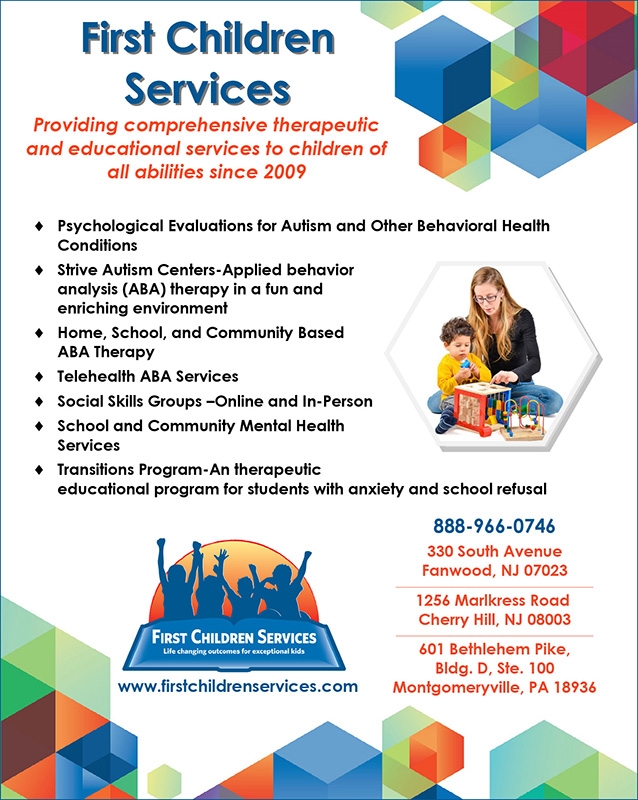For over a decade there has been an abundance of professional articles and seminars on the potential of telehealth and distance learning services. Outside of the medical world, the movement of state licensing bodies and insurance payers to permit use of telehealth services by licensed behavioral health clinicians and BCBA’s has been glacial. In March 2020 we witnessed the rapid, crisis-driven implementation of telehealth and related development of transformative educational interventions for consumers of our services. This article will describe the rapid mobilization of First Children Services’ (FCS) telehealth ABA, mental health interventions and distance learning to sustain continuity of care for special needs children.

First Children provides ABA and mental health services through clinics, in-home and school settings. FCS also operates a special needs school, a therapeutic education program for youth with severe anxiety and supports children in New Jersey district homebound programs. The emergent COVID-19 crisis jeopardized the continuity of our clients’ autism and related educational services.
The Clinical Team made the difficult decision to close FCS’ clinics but determined to continue providing exceptional ABA services to prevent regression of learned skills or the reemergence of problem behaviors. After learning how to implement telehealth ABA services, clinically informed individual decisions were made about continuing care via telehealth or by providing in home ABA treatment. Parents were mostly on board with this plan while a few of our families elected to suspend services until current COVID-19 restrictions are lifted.
Training on CDC guidelines commenced with a review of safety requirements for continued in-person services such as temperature checks, PPEs, hand washing and social distance. Subsequently, staff were provided PPEs, and it was decided to reduce staffing to one Registered Behavior Therapist (RBT) in one home per day. BCBA supervision proceeded via telehealth to minimize risk. Next, parent and employee agreements were prepared which outlined expectations for continued social distancing, reporting potential exposures, and compliance with CDC guidelines for in home services.
Clinical leadership spent two weeks attending ABA telehealth webinars and reading relevant literature to gain telehealth competency. The CASP organization (Council of Autism Service Providers) was noteworthy in disseminating comprehensive support to First Children and other ABA providers to enable timely telehealth competency.
Clinical leadership then conferenced with each BCBA regarding modifications of treatment plans, materials, or behavior interventions while planning for the effective implementation of telehealth services. RBTs were also trained to deliver instructions, collect reliable data, modify materials, provide reinforcement and respond to problem behaviors via telehealth.
Respective BCBAs held parent/caregiver meetings to review expectations, complete the telehealth consent forms, test home technology and address any concerns. RBTs then conducted 2-3 pairing sessions with clients via telehealth. Once ABA telehealth sessions were initiated, some RBTs began with 15-minute sessions and session lengths were increased towards 60 minutes, as clients adjusted to telehealth services.
Within two weeks as telehealth providers, BCBA’s found that individual ABA telehealth services were not as effective as in person services. Our team believes part of this could be due in part to lower utilization of telehealth hours compared with in person therapy. Telehealth ABA services does seem effective in preventing some skills regression. In contrast, parent training appeared to be more effective via telehealth. The increased engagement of parents observed is likely due to the convenience of engaging with a provider in ones’ home – with or without their children present. Clinical leadership is enthused by the potential of telehealth and expects to continue providing parent training telehealth after the of COVID-19 threat has subsided.
First Children’s Transitions program addresses the needs of 34 school avoidant middle and high school aged students who suffer from anxiety and other emotional disorders, including autism. Academic instruction is provided in a classroom setting and both group and individual therapeutic services are integrated into programming with the goal of maximizing school attendance.
Novel methods of delivering distance learning services were devised following the onset of the COVID-19 crisis. Laptop computers and printers were delivered to all students in need. Supervisors used Microsoft Teams to guide the teachers in developing specific written and live virtual contact which enabled delivery of meaningful and engaging assignments that met the specific needs of the students.
Concurrently, tele-behavioral individual and group therapy services were adopted and provided to students on their scheduled basis. In situations where students were acutely struggling with the stress of their COVID-19-related circumstances, licensed staff clinicians, in concert with CDC guidelines, provided intensive in-home therapeutic support.
First Children also provides traditional homebound services in New Jersey under the direction of Susan Goldman, M.Ed. These services quickly transitioned to a distance learning model via Instructor’s use of Skype, Google hangouts, Zoom, Instagram and Facetime to connect with students. This enabled continued work on classroom assignments, projects, essays, and labs while keeping students on target with their counterparts in “regular” district classrooms.
The First Children School serves over 100 students with multiple disabilities for whom distance learning and remote clinical servicing was unimaginable when the pandemic hit. Most students receive multiple therapies including speech, occupational, and physical therapy. Many students are blind, visually impaired, or deaf. Some children require behavioral support including one-to-one intervention. Accordingly, a variety of factors were considered before adopting specific methods for delivering educational and therapeutic services adopted during this time.
Parents have always been active members of the IEP team but have become truly key partners with the teachers and therapists in identifying needs and the best means of providing educational and therapeutic services within their homes. Staff have engaged the families and students in both familiar and new ways. Ongoing communication between our teachers and therapists provided families with coordinated plans that included activities, vocabulary, and strategies to be embedded into a student’s daily routine and natural environment. Initial communication with families helped to identify preferred means of contact, accessible equipment and materials and a description of the home environment. All are important components in the design of a distance learning program that would meet the needs of the students and their families. While bringing students, families and staff together has been the school staff’s best practice, social distancing was not. Thus, new, and comfortable ways of bringing everyone together were created such as daily video conferencing with teachers, therapists, nurses and virtual IEP meetings.
The needs of our families were as unique as the needs of our students, and the Team needed to learn how to individualize. Thus, staff proceeded to identify the essentials of these natural environments and plan accordingly. A major task was practicing these new ways of access. The team’s favorite phrase was “keep it simple.” Staff also had to consider the needs of the new instructors, as parents provided them with clear and appropriate guidance. The overarching goal was to create an environment of support to enable staff and families to “ask for help” as well as “provide it.” Most of all we needed to continue with the familiar into the future when we return to school without totally abandoning new ways of connecting via Microsoft teams, Zoom and virtual instruction. We continue to celebrate the engagement of our families in these new and exciting ways. The school’s staff have learned a lot over the past six weeks and will continue to grow and change.
COVID-19 will not be the death knell for traditional models of behavioral health and special education. Going forward, schools, offices and clinics will re-open and providers will succeed by embracing a blended model that incorporates telehealth and distance learning services. This flexible approach will help insure good outcomes for clients regardless their physical locations.
For further information on First Children Services please contact Matt Hess at mhess@firstchildrenservices.com.






[…] Original Article […]
[…] Utilizing Digital Media to Enable Continuity of Autism Services […]
[…] team can also go to your home or other community locations in order to ensure service continuity. Telehealth is also […]